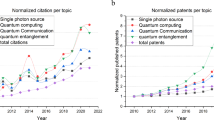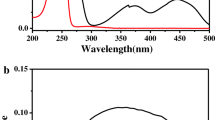Abstract
In this work, we have studied quenching of the fluorescence of two well-known oxygen probes, 1-pyrene butyric acid (PBA) and tris(2,2’-bipyridine)ruthenium ([Ru(bpy)3]2+) by reactive oxygen species (superoxide anion, nitric oxide derivative, hydrogen peroxide) and by the O2 molecule. Both, time-resolved and steady state fluorescence measurements were performed in solution (ethanol, dimethyl sufoxide, water) and in micelles of Sodium Dodecyl Sulfate that serve as a model for membrane-containing biological structures. We have found that only the free radicals and O2 can actively quench for the two probes, but not the diamagnetic H2O2. Our data correspond to the classical Stern–Volmer equation. H2O2 has an effect only at high molar concentrations (>0.1 M). In contrast, effective concentrations of free radicals and O2 that lead to quenching are in millimolar range. In conclusion, our methods allows for detecting global ROS that are small free radicals without interference from the reactive hydroxyl radical. Our data suggest that the method can be used for the quantification of ROS in individual living cells based on the measurement of fluorescence lifetime of those probes.



Similar content being viewed by others
References
Borisov SM, Wolfbeis OS (2008) Optical sensors. Chem Rev 108(2):423–461 doi:10.1021/cr068105t
Lo L-W, Koch CJ, Wilson DF (1996) Calibration of oxygen-dependent quenching of the phosphorescence of Pd-meso-tetra(4-Carboxyphenyl)porphirine: a phosphor with general application for measuring oxygen concentration in biological systems. Anal Biochem 236(1):153–160 doi:10.1006/abio.1996.0144
Sasso MG, Quina FH, Bechara EJH (1986) Ruthenium(II) Tris(bipyridyl) ion as a luminescent probe for oxygen uptake. Anal. Biochem. 156(1):239–243 doi:10.1016/0003-2697(86)90178-8
Vaughan WM, Weber G (1970) Oxygen quenching of pyrenebutyric acid fluorescence in water. A dynamic probe of the microenvironment. Biochem 9(3):464–473 doi:10.1021/bi00805a003
Vanderkooi JM, Erecinska M, Silver IA (1991) Oxygen in mammalian tissues: methods of measurement and affinities of various reactions. Am J Physiol-Cell Physiology 260(6 29/6):C1131–C1150
Benson DM, Knopp JA, Longmuir IS (1980) Intracellular oxygen measurements of mouse liver cells using quantitative fluorescence video microscopy. Biochim Biophys Acta 591(1):187–197 doi:10.1016/0005-2728(80)90232-7
Huglin D, Seiffert W, Zimmermann HW (1995) Time-resolved microfluorometric study of the binding sites of lipophilic cationic pyrene probes in mitochondria of living HeLa cells. J Photochem Photobiol B 31(3):145–158 doi:10.1016/1011-1344(95)07191-1
Dobrucki JW (2001) Interaction of oxygen-sensitive luminescent probes Ru(phen)32+ and Ru(bipy)32+ with animal and plant cells in vitro. Mechanism of phototoxicity and conditions for non-invasive oxygen measurements. J Photochem Photobiol B 65(2–3):136–144 doi:10.1016/S1011-1344(01)00257-3
Mik EG, Stap J, Sinaaseppel M, Beek JF, Aten JA, van Leeuwen TG, Ince C (2006) Mitochondrial PO2 measured by delayed fluorescence of endogeneous protoporphyrinIX. Nat Methods 3(11):939–945 doi:10.1038/nmeth940
Suhling K, French PM, Phillips D (2005) Time-Resolved fluorescence microscopy. Photochem. Photobiol Sci 4(1):13–22 doi:10.1039/b412924p
Gerritsen HC, Sanders R, Draaijer A, Ince C, Levine YK (1997) Fluorescence Lifetime Imaging of Oxygen in Living cells. J Fluo 7(1):11–15 doi:10.1007/BF02764572
Zhong W, Urayama P, Mycek M-A (2003) Imaging fluorescence lifetime modulation of a ruthenium-based dye in living cells: the potential for oxygen sensing. J Appl Phys 36(14):1689–1695
Sud D, Zhong W, Beer DG, Mycek M-A (2006) Time-resolved optical imaging provides a molecular snapshot of altered metabolic function in living human cancer cell models. Opt Express 14(10):4412–4426 doi:10.1364/OE.14.004412
O’Riordan TC, Fitzgerald K, Ponomarev GV, Mackrill J, Hynes J, Taylor C et al (2007) Sensing intracellular oxygen using near-infrared phosphorescent probes and live-cell fluorescence imaging. Am J Physiol Regul Integr Comp Physiol 292:1613–1620 doi:10.1152/ajpregu.00707.2006
Cramb DT, Beck SC (2000) Fluorescence quenching mechanisms in micelles: the effect of high quencher concentration. J Photochem Photobiol A 134(12):87–95 doi:10.1016/S1010-6030(00)00249-5
Denicola A, Souza JM, Radi R, Lissi E (1996) Nitric oxide diffusion in membranes determined by fluorescence quenching. Arch Biochem Biophys 328(1):208–212 doi:10.1006/abbi.1996.0162
Ribou A-C, Vigo J, Salmon J-M (2004) Lifetime of fluorescent pyrene butyric acid probe in single living cells for measurement of oxygen fluctuation. Photochem Photobiol 80(2):274–280 doi:10.1562/2004-03-11-RA-109.1
Halliwell B, Gutteridge J (2007) Free Radical in biology and medicine, 4th edn. Oxford, pp 302–308
Li Y, Zhu H, Trush MA (1999) Detection of mitochondria-derived reactive oxygen species production by the chemilumigenic probes lucigenin and luminal. Biochem Biophys Acta-Gen Subjects 1428(1):1–12
Budd SL, Castilho RF, Nicholls DG (1997) Mitochondrial membrane potential and hydroethidine-monitored superoxide generation in cultured cerebellar granule cells. FEBS Lett 415(1):21–24 doi:10.1016/S0014-5793(97)01088-0
Drummen GPC, Gadella BM, Post JA, Brouwers JF (2004) Mass Spectroscopic characterization of the oxidation of the fluorescent lipid peroxidation reporter molecule C1-BODIPY581/591. Free Radic Biol Med 36(12):1635–1644 doi:10.1016/j.freeradbiomed.2004.03.014
MacDonald ML, Murray IVJ, Axelsen PH (2007) Mass spectrometric analysis demonstrates that BODIPY 581/591 C11 overestimates and inhibits oxidative lipid damage. Free Radic Biol Med 42(9):1392–1397 doi:10.1016/j.freeradbiomed.2007.01.038
Ohashi T, Mizutani A, Murakami A, Kojo S, Ishii T, Taketani S (2002) Rapid oxidation of dichlorodihydrofluorescin with heme and hemoproteins: formation of the fluorescein is independent of the generation of reactive oxygen species. FEBS Lett 511(1–3):21–27 doi:10.1016/S0014-5793(01)03262-8
Rota C, Fann YC, Mason RP (1999) Phenoxyl free radical formation during the oxidation of the fluorescent dye 2′,7′-dichlorofluorescein by horseradish peroxidase. Possible consequences for oxidative stress measurements. J Biol Chem 274(40):28161–28168 doi:10.1074/jbc.274.40.28161
Setsukinai K, Urano Y, Kikuchi K, Higuchi T, Nagano T (2000) Fluorescence switching by o-dearylation of 7-arylocoumarins. Development of novel fluorescence probes to detect reactive oxygen species with high selectivity. J Chem Soc, Perkin Trans 2(12):2453–2457 doi:10.1039/b006449l
Chang MCY, Pralle A, Isacoff EY, Chang CJ (2004) A Selective, Cell-Permeable Optical Probe for Hydrogen Peroxide in Living Cells. J Am Chem Soc 126(47):15392–15393 doi:10.1021/ja0441716
Rharass T, Vigo J, Salmon J-M, Ribou A-C (2006) Variation of 1-pyrenebutyric acid fluorescence lifetime in single living cells treated with molecules increasing or decreasing reactive oxygen species levels. Anal Biochem 357(1):1–8 doi:10.1016/j.ab.2006.07.009
Wilkinson F, McGarvey DJ, Olea AF (1993) Factors Governing the Efficiency of Singlet Oxygen Production during Oxygen Quenching of Singlet and Triplet States of Anthracene Derivatives in Cyclohexane Solution. J Am Chem Soc 115(25):12144–12151 doi:10.1021/ja00078a062
Ribou A-C, Vigo J, Kohen E, Salmon J-M (2003) Microfluorimetric study of oxygen dependence of (1″-pyrene butyl)-2-rhodamine ester probe in mitochondria of living cells. J. Photochem. Photobiol. B Biol 70(2):107–115 doi:10.1016/S1011-1344(03)00072-1
Nelder JA, Mead R (1965) A simplex method for function minimization. Comput J 7:303–333
Chebbo M, Catte M, Richard C (1993) Measurement and prediction of oxygen solubility water-alcohol media. Recent Prog Genie Procedes 7(27):379–384
Tokugawa J (1975) Solubilities of oxygen, nitrogen, and carbon dioxide in aqueous alcohol solutions. J Chem Eng Data 20(1):41–46 doi:10.1021/je60064a025
Franco C, Olmsted J (1990) Photochemical determination of the solubility of oxygen in various media. Talanta 37(9):905–909 doi:10.1016/0039-9140(90)80251-A
Margoliash E, Frohwirt N, Weiner E (1959) A study of the cytochrome c haemochromogen. Biochem J 71(3):559–572
Valentine JS, Curtis AB (1975) A convenient preparation of solutions of superoxide anion and the reaction of superoxide anion with a copper(II) complex. J Am Chem Soc 97(1):224–226 doi:10.1021/ja00834a058
Stern O, Volmer M (1919) The extinction period of fluorescence. Phys Z 20:183–188
Schweitzer C, Schmidt R (2003) Physical mechanisms of generation and deactivation of singlet oxygen. Chem Rev 103(5):1685–1757 doi:10.1021/cr010371d
Demas JN, Diemente D, Harris EW (1973) Oxygen quenching of charge-transfer excited states of ruthenium(II) complexes. Evidence for singlet oxygen production. J Am Chem Soc 95(20):6864–6865 doi:10.1021/ja00801a073
McCord JM, Fridovich I (1969) Superoxide dismutase. An enzymatic function for erythrocuprein (homocuprein). J Biol Chem 244(22):6049–6055 adapted by Sigma-Aldrich
Lokesh BR, Cunningham ML (1986) Further studies on the formation of oxygen radicals by potassium superoxide in aqueous medium for biochemical investigations. Toxicol Lett 34(1):75–84 doi:10.1016/0378-4274(86)90147-5
Wen S, Zhao J, Sheng G, Fu J, Peng P (2003) Photocatalytic reactions of pyrene at TiO2/water interfaces. Chemosphere 50(1):111–119 doi:10.1016/S0045-6535(02)00420-4
Flotron V, Delteil C, Padellec Y, Camel V (2005) Removal of sorbed polycyclic aromatic hydrocarbons from soil, sludge and sediment samples using the Fenton’s reagent process. Chemosphere 59(10):1427–1437 doi:10.1016/j.chemosphere.2004.12.065
Maliyackel AC, Waltz WL, Lilie J, Woods RJ (1990) Radiolytic study of the reactions of hydroxyl radical with cobalt(III), iron(II), and ruthenium(II) complexes containing 2,2’-bipyridyl and cyano ligands. Inorg Chem 29(2):340–348 doi:10.1021/ic00327a037
Choi J-P, Bard AJ (2005) Electrogenerated chemiluminescence (ECL) 79. Reductive-oxidation ECL of tris(2,2’-bipyridine)ruthenium(II) using hydrogen peroxide as a coreactant in pH 7.5 phosphate buffer solution. Anal Chim Acta 541(1–2):143–150
Kubát P, Civiš S, Muck A, Barek J, Zima J (2000) Degradation of pyrene by UV radiation. J Photochem Photobiol A: Chem 132(12):33–36
Lymar SV, Kokorin AI, Parmon VN (1981) Deactivation of electronic excited states of stable nitroxyl biradicals. Izv. Akad. Nauk SSSR [Khim] 11:2616–2618
Suzuki T, Obi K (1995) Evidence for enhanced intersystem crossing on pyrene fluorescence quenching with stable free radicals. Chem Phys Lett 246(1):130–134 doi:10.1016/0009-2614(95)01138-Y
Angelescu D, Vasilescu M (2001) Quenching of pyrene derivatives’ fluorescence by nitroxide radicals in sodium dodecyl sulfate micellar solutions. J Colloid Interface Sci 244(1):139–144 doi:10.1006/jcis.2001.7900
Johnson DA, Nguyen B, Bohorquez AF, Valenzuela CF (1999) Paramagnetic fluorescence quenching in a model membrane: a consideration of lifetime and temperature. Biophys Chem 79(1):1–9 doi:10.1016/S0301-4622(99)00036-8
Rharass T, Vigo J, Salmon J-M, Ribou A-C (2008) Reactive oxygen species in anti-tumoral activity of adriamycin: hypoxic and oxygenated cells. Free Radic Res 42(2):124–134 doi:10.1080/10715760701834552
Acknowledgments
This work was financially supported by the French “Ligue Contre le Cancer- Comité départemental du Gard”.
Author information
Authors and Affiliations
Corresponding author
Rights and permissions
About this article
Cite this article
Oter, O., Ribou, AC. Quenching of Long Lifetime Emitting Fluorophores with Paramagnetic Molecules. J Fluoresc 19, 389–397 (2009). https://doi.org/10.1007/s10895-008-0425-z
Received:
Accepted:
Published:
Issue Date:
DOI: https://doi.org/10.1007/s10895-008-0425-z




